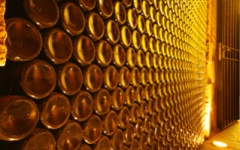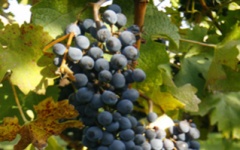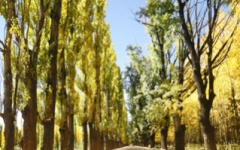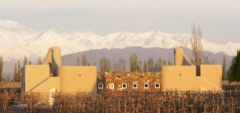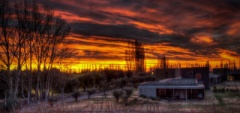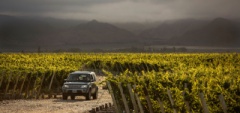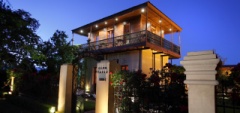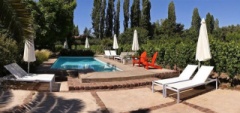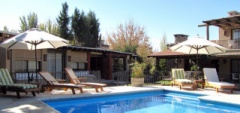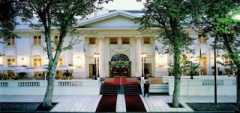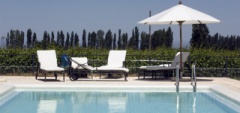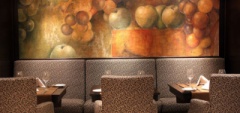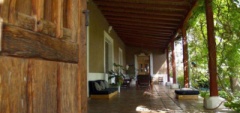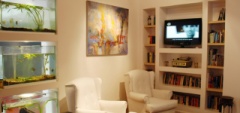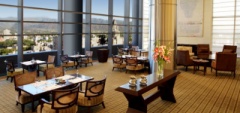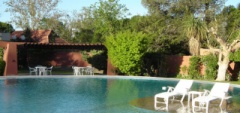The Bodegas
A small collection of some of the more and less well known bodegas in the region
Now established as one of the foremost destinations in the world for those interested in their wine, the many botegas that surround the city of Mendoza are a must see on any trip to the area. One of the benefits to growing grapes in this area is the reliability of the climate, with the great Andes range taking most of the moisture out of the air, and providing the climate with plenty of sunshine throughout the year. As the region has become discovered there has been influx of such growing names as Rochschild and huge investment in equipment and techniques. Below is a brief guide to a few of our favourites:
Bodega Atamisque
Atamisque is a pristine new winery set in the Tupungato area of the Uco Valley in Mendoza. Owned by Frenchman John Du Monceau, Atamique produces its first harvest in March 2007 with good results. The estate vineyards currently have 70 hectares underproduction and a brand new, high tech 500,000 litre winery. In addition to vineyards the property grows apples, pears, cherries and nuts as well as having a trout farm, all nestled up against the foothills of the Andes.
The winery produces its signature Atamisque high-end wines in addition to its Catalpa label.
A tour to the winery is a chance to take a look at this cutting edge facility and offers a chance to visit their cosy restaurant that specialises in trout, a welcome respite from an overabundance of beef…although don’t mention that to the locals! They source almost everything from their own property so be sure to try not only all the delectable trout dishes cut compare and taste with their different wine combinations.
Bodega Benegas
A historic treasure, constructed in 1901, Bodega Benegas is one of the oldest wineries in Mendoza with ancient vines growing along the banks of the Mendoza river. All grapes for their wines are quickly gaining international prestige. To come and take a look at this old winery is to take a glimpse at the history of viticulture in Argentina and is a chance to see how the pastime has slowly turned into a profession.
This winery was constructed with adobe and sits upon an underground cave built to store the casks. Construction was completed in 1901 by Agustin Alvarez, who was the governor of the Province of Mendoza at the time. Due to its long past, the vineyard boasts 100-year old grapevines which give the wine produced by these grapes a particularly earthy taste. Another remnant of the winery’s past is the colossal guestbook, which is right around the same age as the oldest grapevines with some visitors’ notes in beautiful handwriting (quite a rarity it today’s modern society)
The owner of Bodega Benegas, Frederico J. Benegas Lynch, came from a long line of winemakers. Benegas was born in the winery in 1951 during which time his father owned it. He spent his childhood at his father’s side, sampling the wines and working in the vineyard. Having developed a great love for wine, Benegas joined his father and today carries on the family business. He recently restored the old, crumbling building that houses the winery to its original state with adobe and reinforcing.
The upstairs area of the winery houses a social gathering room, complete with seating area, a long dining table and a huge Parilla. Benegas’ valuable personal poncho collection decorates the space along with old relics from the early days of the winery. Downstairs the underground cave is six meters deep with rock walls and soil grounds which store more than 40 French oak barrels with a capacity of 35,000 litres each.
Bodega Cecchin
Bodega Cecchin was born in 1959, fulfilling a family dream; to own a private vineyard and winery with land, ready to become the base for exquisite wines. Currently, Cecchin continues as a family business and has become well known for its organic vineyard and wine production where no type of chemical processing is involved, thus eliminating any contamination and maximizing the qualities that the region’s environment and microclimate provide.
Their organic grapes rely on their sophisticated irrigation system, which is dependent on Mendoza’s natural surroundings. The meted snow that comes down from the neighbouring mountains is a regulated system of irrigation.
Tours to Cecchin have a personal touch, and the wines you can taste and buy at the winery are not easy to find in the shops and are to a very high standard.
Clos de Chacras
Clos de Chacras is a boutique winery originally built in 1921 and is, nowadays, completely restored, respecting its original style and incorporating the highest technology to achieve premium wines, which have been praised repeatedly for their quality and style. The main part of the bodega’s produce is currently exported, mainly to the USA and Brazil.
To achieve the best wine of each variety, Clos de Chacras chooses regions to grow vineyards with the highest potential of grape quality. For this reason they exploit vineyards in Maipu, La Consulta and La Codilla and are currently considering incorporating an additional vineyard in Tupungato for one of their varietals. Being a boutique winery enables Clos de Chacras to harvest and process grapes on the same day, something hard to achieve in large scale productions.
Prior to harvest as removal of clusters from the vines allows the remaining clusters to blossom and reach their full potential. The harvest is done manually and the grapes are put into boxes with a capacity of 125kgs per box. This ensures to keep down grape damaging while in the box. Once transported to the winery the grapes are emptied onto a machine that sorts and separates the grapes. Here, any damaged grapes and extraneous material are discarded.
As mentioned in other areas of the site, a visit to the Clos de Chacras for their tasting menu is an absolute delight and is well worth the effort. Located just at the edge of the small town it is possible to come here for supper or lunch and have a brief look around this traditional building with its adobe storage vats (no longer used), and gentle ambiance.
Familia Zuccardi Winery
The history of Familia Zuccardi Winery is a consequence of the idea of improving the efficient use of water. In 1963 the founder of Familia Zuccardi, engineer Alberto Zuccardi, acquired a plot of land in Maipu (Mendoza) to experiment an irrigation system designed by him and based on methods used in California. After these successful experiments, his passion for viticulture took him to enlarge his grape crops and to begin wine production in 1968.
In those days the activity was run in a very traditional way and focussed on the domestic market. After analysing the main characteristics that the wine industry had worldwide, a decision was taken to produce wine for the international markets. This new challenge implied training personnel and developing new production techniques in Mendoza. After obtaining an important share in major international markets the next step became developing the local market with upgraded international quality produce.
The winery currently produces 800,000 boxes per year, cultivating 650 hectares of vineyards at their own estates in Maipu and Santa Rosa, both in the province of Mendoza. As from 1985 Jose Alberto Zuccardi, the founder’s son, Runs the company where 500 permanent employees work.
Located a 30 minute drive away from the City of Mendoza, Familia Zuccardi has a special wine cave, which is the starting point for instructive visits to the winery. The compete elaboration process is unveiled, from the grape harvest, through production and conservation methods until the sought after final wine tasting!
Ruca Malen Winery
With a sweeping view of the Andes, beyond fields of grapevines, stands boutique winery Ruca Malen. It produces premium wines, mainly Malbec and Cabernet Sauvignon, from 27 hectares of vineyards. Quality, style and elegance are what owners Jean Pierre Thibaud and Jacques Montalembert have been aiming for since they started in 1998.
The bodega tour takes guests from the vineyards and sorting machines to the fermentation and aging rooms, offering an intimate glimpse into the winemaking process from the grape to the bottle. The beautiful modern facilities, informative guides and picturesque location are matched by the quality of its wines.
Ruca Malen’s dream began in 1998, when Pierre Thibaud left the chairmanship of Bedegas Chandon in Argentina. He met Jacques Louis de Montalembert, who had also forged an outstanding career in the winemaking industry in his hometown, Burgundy. Together they soon discovered that they shared the same dream; starting their own winery in Mendoza, a winemaker’s paradise at the foot of the Andes range.
Thus, they joined efforts to work on the Ruca Malen project. The aim was to concentrate on making wines of excellence, based on their knowledge and, above all, their passion for winemaking. Several months later, they produced their first bottling, the 1999 vintage. From its very onset, Ruca Malen has been committed to quality, which translates into wines with style, elegance and distinction.
The winery today – Facilities at Ruca Malen were designed to offer an easy expansion of productive capabilities. The firm recently invested 2 million dollars in an expansion project to duplicate the installed capacity and achieve a productive potential of one million litres. Currently, the winery produced three brands Yauquen, Ruca Malen and Kinien
Bodega Vistalba by Carlos Pulenta
The Pulenta family has been involved in Argentine viticulture for three generations. Carlos Pulenta, renowned for his dedication to quality and terrior, created the lovely Vistalba winery to offer guests luscious wines, luxury accommodation and La Bourgogne, a world class French restaurant.
Carlos worked for seven years as president of Salentein, a Dutch company that owns three bodegas in and around Mendoza. He increased the number of European varietals, installed the latest technology and put Salentein wine on the tables of the world. Leaving in 2004 he returned to his family’s land in Vistalba where he built his own bodega in the middle of the vineyard.
The courtyard entrance frames a perfect view of the 4,900m Cordon de Plata mountain range. More than a bodega, the light stone and polished concrete complex houses an ultramodern 12 room inn, perhaps the best restaurant in the region, elegant meeting rooms, and underground salon for private parties and a conference centre.
Inside the bodega, glass walls expose the tumbled rocks and dirt that Malbec thrives in. There are architectural surprises around every corner as you explore the cellars. Pulenta and his team of family advisors and oenologists have created three blends using Malbec, Cabernet. Merlot and Bonarda, plus a delicate Sauvignon Blanc.
Salentein
An entirely new focus on quality is apparent at Salentein where the long established varietals are produced, the old vineyards are preserved and the traditional European techniques blend with state of the art technology to produce international quality wines that have been on sale in major cities throughout the world since 2000.
The winery’s vineyards cover 455 hectares that include plots in different positions, varied soil types and altitudes that go from 1050 to 1700m which allow for exceptional adaptation of the different grape varieties. The water used for irrigation comes from mountain snow and its purity, together with the precise quantity and moment it is applied, produces low pH levels in the grapes, resulting in a superior acidity and colour that flavour the wine’s development.
The building that houses the Salentein winery is unique, cruciform construction. Each wing of the cross is a wine cellar with two level; the ground floor holds French stainless steel tanks and oak vats for the fermentation process and storage. The underground level is where the wine is sent to complete the aging process in oak barrels. The two levels are designed to allow the wine to descend to the barrels below by traditional gravity method. The four wings converge in a central circular amphitheater lit magically from above by a huge skylight, inspired by ancient temples.

